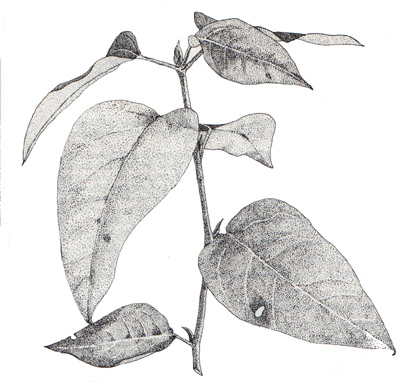

Poplar or Cottonwood
Populus balsamifera
(Salicaceae)
Description:
A medium-sized tree, usually 30 to 50 feet (9 to 15 meters)
tall, poplar has a straight trunk with bark that acquires deep diamond-pattern
ridges in older trees. The winter buds are the largest, most aromatic, and most
sticky-resinous of the deciduous trees. These buds are about 1 inch (2.5
cm.) long, pointed, and covered with shiny brown scales. They release a
pungent balsam odor. The twigs are reddish brown and the leaves, with slender
petioles, have sharply pointed blades, rounded bases, and many small, rounded
teeth along the margins. The flowers form long, hanging catkins.
Distribution:
Poplar, which can hybridize with quaking aspen, is distributed
throughout Alaska (except the coast) and across North America. It is especially
common on well-drained gravel along rivers and occurs farther north than any
other tree species.
Constituents:
The buds of Populus candicans, a relative, contain
a balsamlike resin, a yellow volatile oil (primarily humulene), gallic acid,
malic acid, mannite, chrysin, tectochrysin, a fixed oil, and two glycosides,
salicin and populin. (Populin is salicin benzoate.) (Spoerke)
The antibiotic trichocarpin, active against fungi, comes from the bark of P. candicans; bisabolol, active against tuberculosis bacilli, comes from young shoots of another relative, P. tacamahaca. (Lewis and Elvin-Lewis)
Medicinal Uses:
The salicin in poplar buds has some action against fever
and pain; the resin yields a terpene to which many therapeutic effects are attributed.
(Spoerke)
Poplar buds, used externally, are mild as a counterirritant or expectorant. Cottonwood bud tea is used for colds by Interior Alaskans. (Hall) Salve from the winter buds of P. balsamifera is simple to make. (See balm of Gilead procedure, following.) Lime villagers use this as medicine for a sore, rash, or frostbite. (Kari) The Menominees and Pillager Ojibwas rubbed the ointment on the nostrils or put it up the nose, allowing the balsamic vapors to course through the respiratory passages to relieve congestion from colds, catarrh, and bronchitis. They boiled the buds in mutton or bear tallow. (Lewis and Elvin-Lewis) I have used balm of Gilead ointment in this way myself.
The term "balm of Gilead" is applied to an ointment made from the buds of the poplar tree as well as from a totally different tree from Arabia. Collecting the buds is easiest at temperatures just below freezing, when they are frozen enough that they are not sticky and do not adhere to the fingers, but not so cold that hands get chilled. It is the terminal bud that I gather.
The procedure for making balm of Gilead is simply to cover the winter buds with oil, heat them, then strain and use the liquid. Spring buds are all right to use until they have begun to open, when the amount of aromatic oil-soluble resin is relatively less compared to the amount of water and water-soluble materials.
The kind of oil to use is a matter of personal preference. One book recommends wolverine fat, but usually I use a fine vegetable oil and then add some beeswax to the point where it does not run, but has the thickness of a lotion. Vaseline or cocoa butter work very well also, as would lard, lanolin, or solid shortenings. The heat should be low enough to warm but not boil the oil, or the buds might burn. To maximize the extraction, the amount of time to heat can be extended for days if the pot is on the back of the wood stove, but twenty minutes would be a reasonable time on a low fire.
Christopher lists the following herbs to add to the balm to increase its efficiency: anise root or sweet cicely, chickweed, coltsfoot, horehound, hyssop, licorice, lobelia or red sage.
Poplar bark is cathartic, tonic, stimulant, diuretic, anti-scorbutic, Stomachic, resolvent, discutient, alternative, expectorant. The buds are stimulant, tonic, diuretic, expectorant, nephritic, demulcent, cathartic, Peristaltic, and nutritive. (Christopher)
Copyright © 1987 by Eleanor G. Viereck